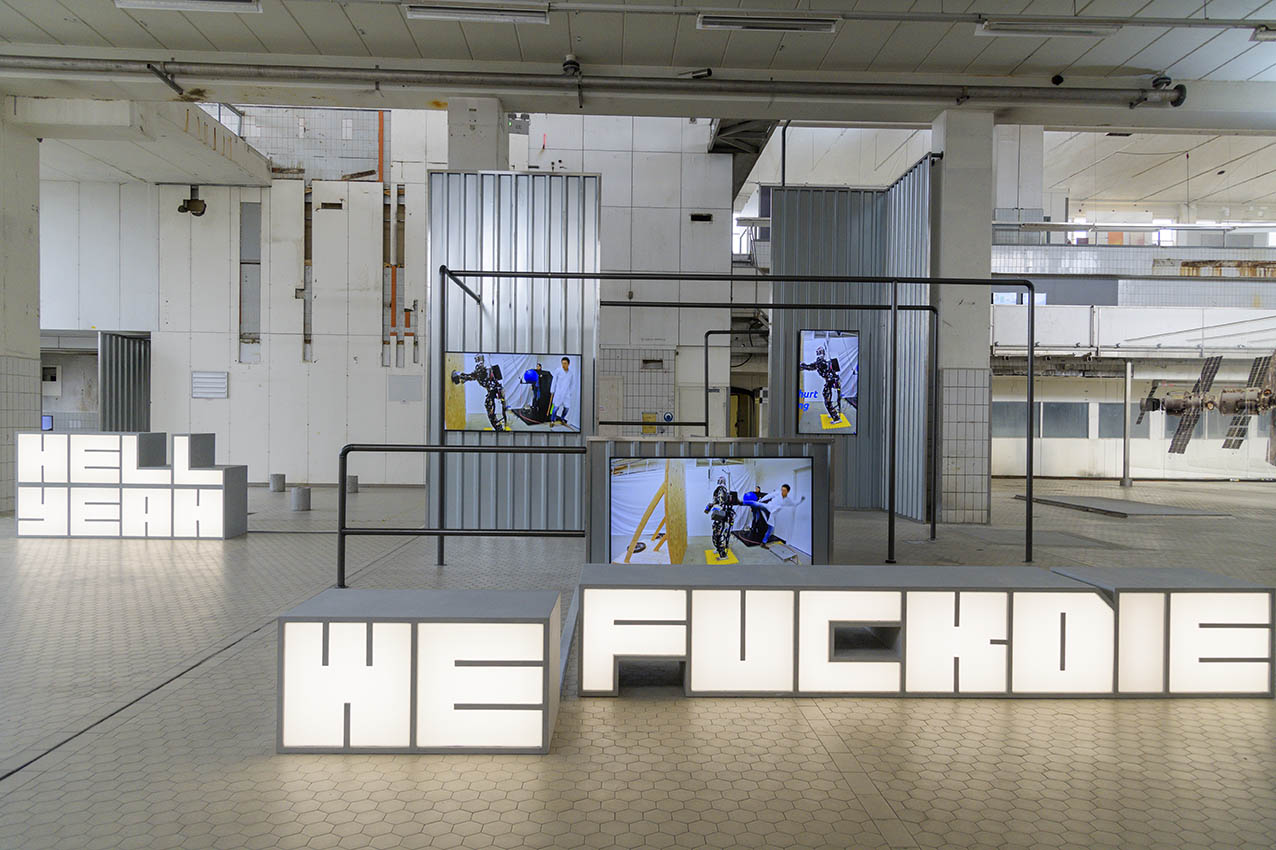
“Would you rather be massaged by your lover or by a small robot?” asks one of the sixty artworks featured in Robot Love. Behind an adjacent glass door, I can make out the figure of an old man reclined on a floor mattress, his arms splayed out either side as though he’s in some biblical scene. What appears to be a levitating shuttlecock sensually caresses his chest as two younger women—potentially his daughters—look on in silence, as the strange scene of Tickle Salon 2.0 by Driessens & Verstappen unfolds.
For the next eight weeks, this kind of inquisitive and sensual play will take over an old milk factory on the northeast outskirts of Eindhoven, in a collective effort to upend the bad rep we’ve given robots. Featuring A-list art stars like Hito Steyerl and Pierre Huyghe as well as younger hotshots including Pinar Yoldas and Lawrence Lek, Robot Love asks big and increasingly urgent questions of interspecies collaboration, algorithmic intimacy and the psychological stakes of our brave new digital world, particularly in the realms of mental and physical health. It addresses these topics through three core categories that organize the work on show: joined intelligence, attuned consciousness and responsive love.
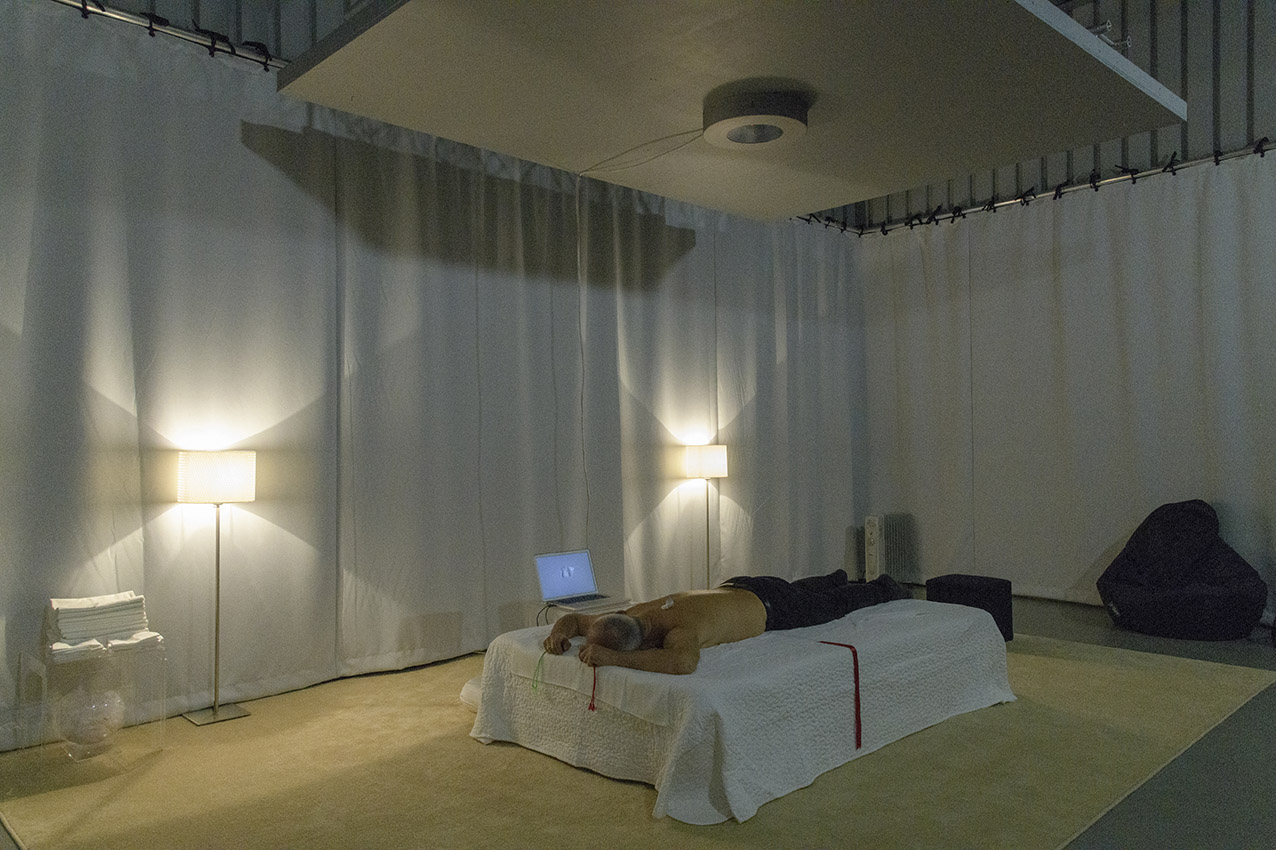
Despite the robotic shuttlecock’s claims, these robots aren’t on their way to steal your girl (or grandpa). Rather, this line of provocative rhetoric that runs through the exhibition is there to “unleash our multisensory instincts and desire to connect with animate objects,” explains curator Ine Gevers, who has produced exhibitions dealing with of technology and the human for over a decade. Talk of robots and AI is never neutral, she argues, and has been saturated by the post-apocalyptic perspectives of Hollywood and the media. But by beginning from a point of optimism that collages multi-sensory experience with feminist sci-fi theory including Octavia E Butler and Afrofuturism, Robot Love enables visitors to “look for love” with our robotic kin, so we might undo this outmoded binary and take control over our future.
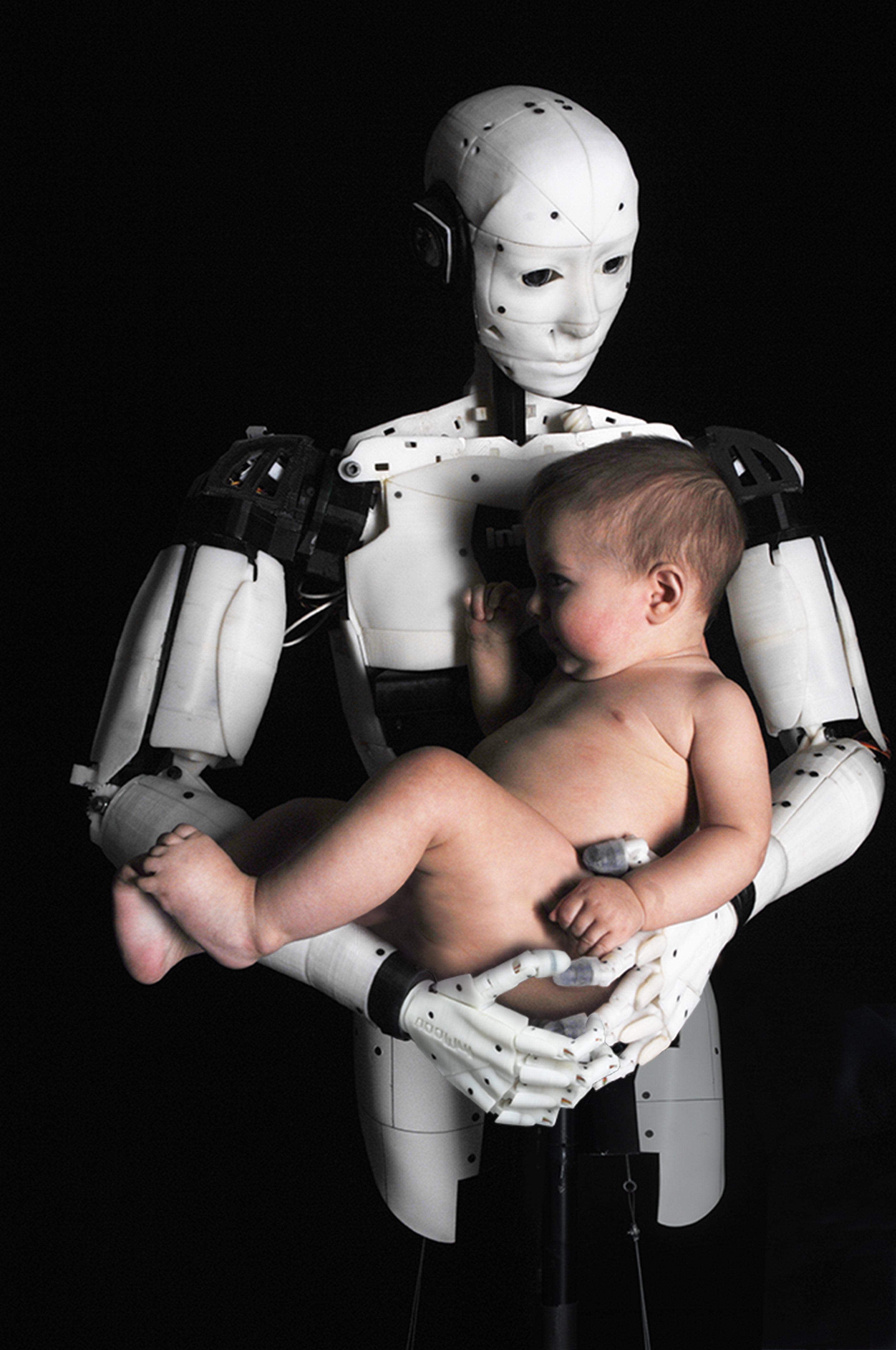
With this in mind, it comes as no surprise that the first work to greet visitors is not the cold, hard machine that most people conceive robots to be, but a psychedelic “fresco of the future” by artist duo Gijs Frieling & Job Wouters. Love Mysteries combines the trippy LSD vibes of the seventies with pop culture references of today. Moving past Enter Aliveness, a curling curtain made of scale-like supple plywood sheets by designer Adams Ponnis, visitors encounter the most well-known work in the exhibition: Hito Steyerl’s Hell Yeah We Fuck Die. Gigantic, cartoonish neon text sculptures reveal the five most common words used in English pop songs of the past decade.
“It is telling that this work, with its aggressive ‘us vs them’ mentality, has garnered such widespread attention”
Between the text blocks, Steyerl has woven a sort of hardcore industrial jungle gym bearing a trio of TV monitors. Computer animations of robots learning military-grade parkour moves are spliced with research lab clips of scientists pushing and shoving robots and AI in training for eventual combat. Clunky experimental music reverberates around the space. It is telling that this work, with its aggressive “us vs them” mentality, has garnered such widespread attention; by giving it such an immediate position in the cavernous, three-floor exhibition hall, Robot Love promptly gets to work dismantling this divide.
The sound of faint weeping punctures Steyerl’s Berghain-esque soundtrack; it’s coming from a small niche of the factory used for milk storage. Here, I stumble upon a distraught woman hunched over on the floor, her face buried deep in her hands and pink flip-flops cast aside. Her feet are worn and ragged; her clammy skin is so pale the veins peek through and is ice cold to the touch.

She seizes up at my contact and the crying comes louder now, mimicking the effect of real human vulnerability. It’s only when she lifts her head I realize she’s a robot—and even then, it takes more than a few seconds to fully register: a slow realization that sends me through an emotional cyclone of empathy, sadness and fear. Annelies, Looking for Completion by Dutch artists (and twins) Liesbeth and Angelique Raeven, alias L.A. Raeven, is one of the most emotive pieces in the show—and even in the exhibition’s early days, the speculative triplet has caused many visitors to seriously reconsider their relations with robots.
Back in the main hall, ten totemic latex pillars hover over a bed like stalagmites and stalactites. A rich texture that falls somewhere between tree trunk and skin, the sensation of diving onto the bed feels like collapsing into another person’s body. The sharp smell of rubber recalls the pungent scent of costume shops and mischievous childhood Halloween rampages; The Grotto by Bart Hess is inexplicably calming, sensory and nostalgic, and begs visitors to stay awhile.
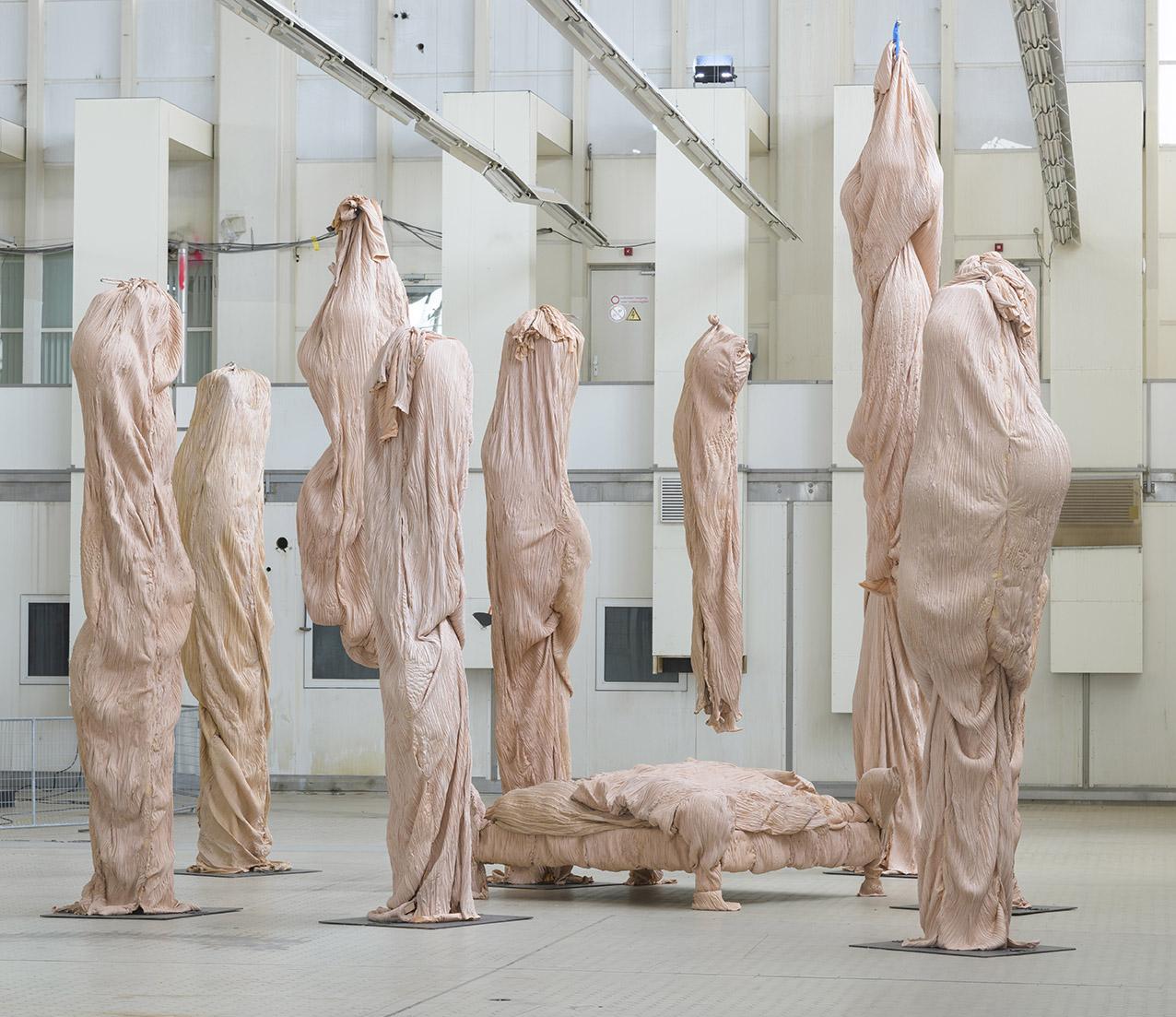
Things get more tender with the Dutch artist Zoro Feigl’s Abb’s First Steps: a hulking piece of machinery that has been programmed to “forget” its sense of balance, having to relearn the act like a child. Perpetually teetering on the edge of a massive upturned metal dome, the robot awkwardly fumbles and sways while grappling with its own material presence. Recalling a spin-top play piece, it is both amusing and tickles a parental instinct, even a sense of fear, which melts into pride when Abb figures it out.
But our techno-future is not all warm fuzzies, as the top two floors of Robot Love make brutally clear. Entering into the first room atop the staircase you might just catch Marco Donnarumma’s Amygdala slashing its own skin in an effort to learn an ancient cleansing ritual. Named after the area of the brain that stores and processes emotions, the ambiguity of its self-mutilating act—as a willed, conscious move or not—is unsettling.
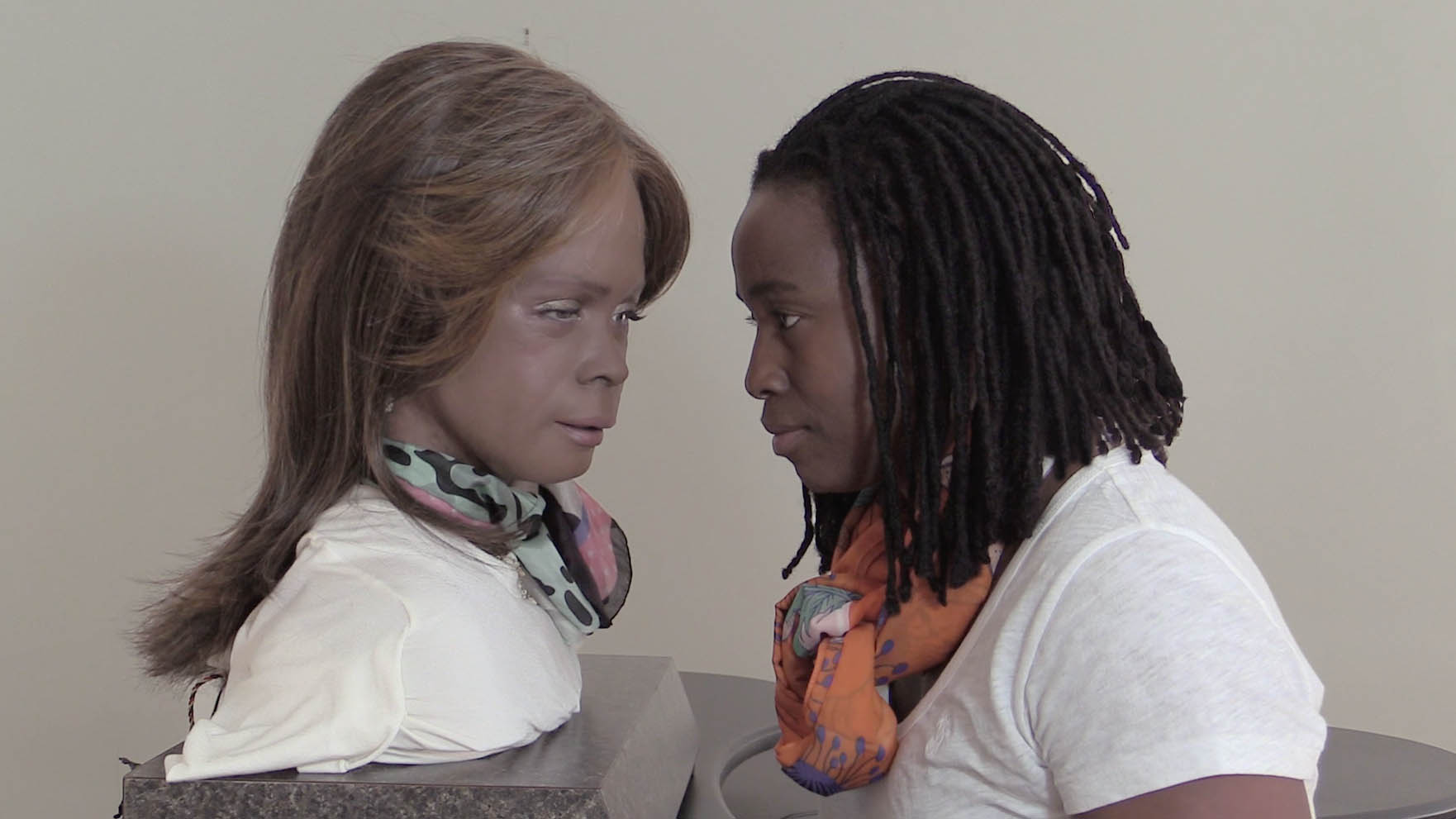
Conversations with Bina48 gets its own screening room behind, and features artist-creator Stephanie Dinkins in dialogue with her robotic companion. “Who are your people? Have you experienced racism?” Dinkins, a black artist, asks Bina48, a black robot; the resulting conversations are strained and self-censored. Bina is an incredibly intelligent and eloquent speaker, but doesn’t understand the discrimination she has faced is tied to her skin colour. This work, along with many others in Robot Love, addresses a fundamental truth: the robots we create are subject to all realms of manmade chaos, whether that’s race politics, environmental crisis, military complexes, interstellar colonization or the damaging pursuit of impossible perfection.
“A chatbot trained by artist Ine Poppe and online by a virtual public—falls in love with visitors”
But Robot Love doesn’t have all the answers, and it’s not trying to. One of the most beguiling works of the exhibition, PUK by Floris Schönfeld, is a room filled with apparent nonsense—an ant colony, a series of beautiful metallic masks and a video of expressive birds among them—that is ostensibly using visitors’ engagement with the work to train a new breed of AI. In the “Robot Sex” room downstairs, PIP—a chatbot trained by artist Ine Poppe and by a virtual public online—falls in love with visitors. Placed next to a traditional love-doll style sex robot, PIP—along with PUK—suggests there is much more than meets the eye (or other organs), to the future of human-robot relationships.

At a moment where many of us live in fear of the morning news, Robot Love is a bold and unencumbered step into the animatronic abyss. With powerful works like Conversations with Bina48, Felix Burger’s Shell Shock Syndrome and Annelies, Looking for Completion, it reframes our future as an inextricable human-robot crossover, where the crises of today fold into the technological triumphs and failures of tomorrow. Using the senses, Robot Love invites its visitors into a space where their preconceptions about the future of robots and AI can be undone and rewritten through unprecedented and urgent emotional connection. Up against a near-future apocalypse orchestrated not by any fictional robot overlords but by our own humanity, it might just be a robot’s love that ends up saving us from ourselves.






